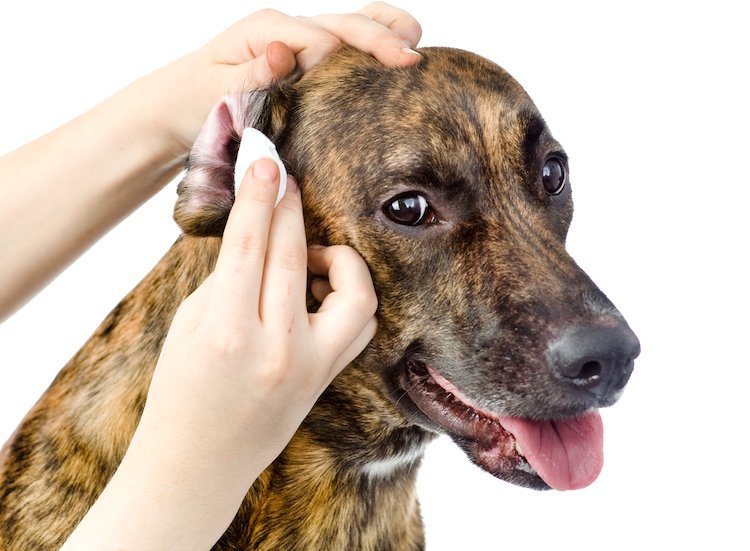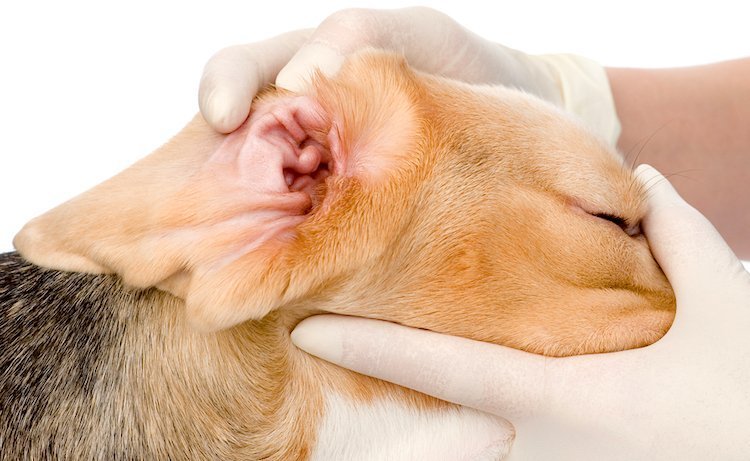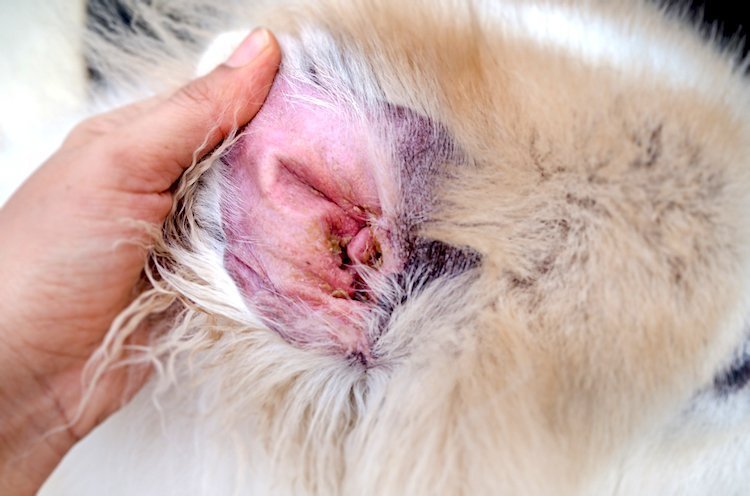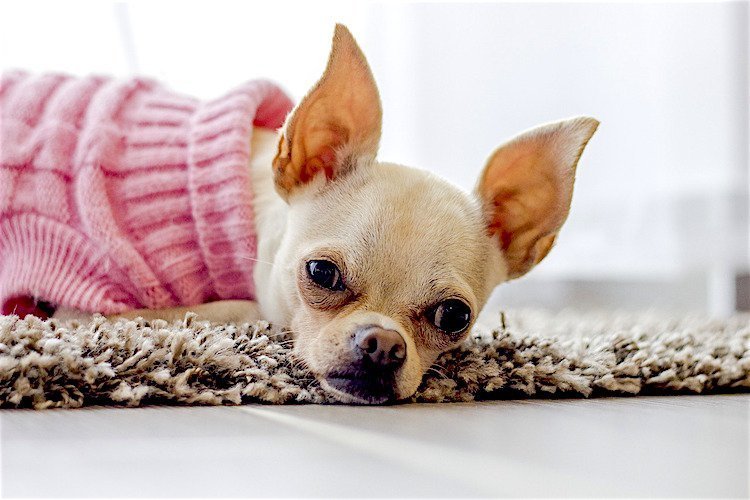
Is ear cleaning good or bad for your dog? And if it’s good, what’s the right way to do it?
The truth is, cleaning a dog’s ears wrong damages the ear. But clean them right, and it promotes good health — like any year-round grooming.
This article gives you sound advice on what to use, when to use it and how to clean dog ears to cut down on vet visits.
Do I Need to Clean My Dog’s Ears?
One of my favorite sayings is: “If it ain’t broke, don’t fix it.” So let’s start at the beginning by working out if your dog actually needs their ears cleaned or not.
Give the Ear the Sniff Test
Lift your dog’s ear flap and give the ear a good sniff. How does it smell?
If the answer is “My dog’s ears stink,” then you’ll need to clean those smelly dog ears.
Other signs that the dog’s ears need attention:
- A bad smell
- Discharge of some sort
- Crusty ear flaps
- Excessive itchiness
- One ear looks different than the other
- A history of ear infections
However, a healthy ear may not need cleaning.
Indeed, there are dogs who go their whole life without needing their ears cleaned. These pups are best left alone, since nature has blessed them with good ears. Add in an ear cleaner, especially a “bad” one (more on that below), and you can destroy that delicate balance and invite problems.

What Does a Healthy Ear Look Like?
- A normal dog ear should have nice, pink skin that isn’t inflamed or angry looking. The skin should be supple and soft with a healthy glow to it.
- Conversely, an ear that glows an angry red or has ulcers, feels or looks greasy, or has a discharge or flaky skin is not normal.
The entrance to the ear canal should be a distinct dark hole. A narrow ear canal can indicate long-term, low-grade inflammation.
Now compare one ear with the other: Do they both look the same? If they do, then chances are those ears don’t need cleaning.
What Does Discharge From the Ears Mean?
What is the brown stuff in my dog’s ears?
Dogs do produce ear wax but not in any great volume. Although a small amount of brown wax can be normal, if there are lumps of it or it’s plugging the ear canal, then this is not normal.
- Lumps of brown wax in your dog’s ears indicate a yeast infection or that ear mites have moved in. These ears are liable to be itchy, and the dog keeps you awake at night with the thump-thump of a back leg.
- Cream-colored, yellow or green discharge from your dog’s ears indicates infection. If this is the case, don’t delay — see the veterinarian now. This isn’t going to settle down without treatment, and a delay will allow the infection to become better established.

Should I Clean Smelly Dog Ears?
Sometimes no, but mostly yes.
Do NOT clean your dog’s ears if:
- The dog has a head tilt: This can indicate a middle or inner ear problem. If the ear drum is ruptured and you put cleaner it, this can be toxic to the inner chambers of the ear. For more, see my article “Why Does My Dog Suddenly Have a Head Tilt?”
- The dog is in pain: They may need pain relief from the vet before the ear can be touched.
- There’s a cream, yellow or green discharge: This needs treatment, and the vet may need to swab the discharge for culture and sensitivity.
- The skin has sores or is inflamed: An ear cleaner in contact with ulcerated skin may be very painful.
Bleeding or Swelling: See Your Veterinarian
Bleeding or swelling? See your vet.
But otherwise, if your dog has a lot of brown wax or if the ear is generally stinky, you may go ahead and give it a clean with a good ear cleaning solution — which I’ll tell you more about below.
Was YOUR Pet Food Recalled?
Check Now: Blue Buffalo • Science Diet • Purina • Wellness • 4health • Canine Carry Outs • Friskies • Taste of the Wild • See 200+ more brands…

How Often Should I Clean Smelly Dog Ears?
The answer to this question is a little long-winded, but bear with me — all dogs are different.
If your dog’s ears need cleaning to prevent recurrent ear infections, you vet is best placed to guide you about how often.
You’re aiming for the sweet spot, where you remove debris that could play host to bacteria and mites — but without over-cleaning and damaging the skin’s natural balance.
- For a normal ear cleaning, once every 2–4 weeks is sufficient.
- If a dog gets regular ear infections, I advise cleaning the ears every 1–2 weeks. If the cotton wool comes back clean, then you don’t need to do anything until the next cleaning.
- But if the cotton wool is really mucky, clean the ears again the next day. Repeat. If the cotton wool is still mucky, then clean for a 3rd day. And if on the 3rd day the cotton wool is still mucky, then see the vet.
This helps you spot an ear infection early and seek help before it becomes established. But try to avoid unnecessary visits because the ear just happens to be a bit waxy that day.

What Is the Best Dog Ear Cleaner?
You may be wondering, “What can I use to clean my dog’s ears at home?” or “How can I clean my dog’s ears naturally?”
Here’s the deal: What you use to clean the ears matters — a lot!
If you use the wrong dog ear cleaner, you can turn a healthy ear into an infected one.
To understand this, think of the last time you had a good soak in the bath. What happened to your fingertips?
They became prune-like, didn’t they? This is called “maceration” and is due to the skin absorbing water and swelling up. The same thing happens if you put water-based cleaners into a dog’s ear. And that weakened skin is then more vulnerable to infection.
Wondering how to clean dog ears with vinegar? Or how to clean dog ears with hydrogen peroxide? My advice: Do not attempt either of these.
If you put straight-up vinegar or hydrogen peroxide in an ear, these are too harsh. Like paint stripper on a piece of old furniture, they strip away the protective oils that keep the skin hydrated and supple.
Hydrogen peroxide and vinegar cause excessive drying of the dog’s ear and again weaken the skin and open it to infection. These can be used when well diluted … but then you have the problem of introducing too much water into the ear, so they’re best avoided.
The best dog ear cleaner has properties such as:
- It evaporates quickly to avoid “wetting” the ear canal.
- It’s sympathetic to the skin’s natural pH.
- It gently dissolves wax and debris without stripping away oil.
- It doesn’t sting or irritate the ear canal.
Best Dog Ear Cleaner: My Favorites
My personal picks for best dog ear cleaner include Virbac Epi-Otic and Vétoquinol Ear Cleansing Solution.
Although Virbac is more expensive, it’s very effective and can help cut down on the frequency of infections.
Oh, and a quick word about dog ear cleaning wipes: These clean only the outer parts of the ear, so wipes are not very effective. The ear canal is a surprisingly long tube, and wiping the top is like washing just the rim of your hot chocolate mug — there’s a lot of sticky stuff left at the bottom.
Watch this quick video on how to clean dog ears:
Step-by-Step Instructions: How to Clean Dog Ears
You have the best dog ear cleaner — now what?
Here, finally, is the part where I’ll explain exactly how to clean those dog ears.
Before you start, have a friend gently hold the dog so you have both hands free. (Or sit the dog in the corner of the room so the dog can’t run away.)
How to Clean Dog Ears
- Lift the dog’s ear flap.
- Hover the nozzle of the ear cleaning solution over the dark hole (the entrance to the ear canal). Squeeze the bottle, allowing the ear canal to slowly fill to overflowing with cleaning solution.
- Place a plug of cotton wool — not a Q-tip — into the dog’s ear.
- Massage the ear below the plug of cotton. You’ll hear a squishy noise if you’re in the right place.
- Remove the cotton and wipe away any excess cleaner with more cotton wool.
- Let the dog shake their head, then repeat on the other side.
Here’s our handy illustrated guide to cleaning a dog’s ears:

Additional Notes on How to Clean Dog Ears
You can use the best cleaner in the world, but if you’re stingy with the amount, it’s not going to work.
The ear canal is long and bendy and can hold a lot of liquid. You need to be generous — lavish even — with the amount of ear cleaner you put in.
Squeeze the cleaner in until it overflows or you see a pool of it sitting in the ear canal. Now massage the ear canal. Again, you’ll know when you’re in the right place — you’ll hear a squidgy sound. Some dogs love this and push their head against your hand as though you’ve hit the spot of an itch.
Use a new piece of cotton wool to wipe away the excess dribbling out of the ear. Then stand back and let the dog shake their head. This brings muck and debris up to the surface for you to wipe away.
And ta-da! Clean ears.
Can I Clean My Dog’s Ears With Q-Tips?
No. Do not use a Q-tip to clean a dog’s ears.
Medics have a saying about human ears: “You shouldn’t put anything smaller than an elbow into the ear canal.” The same goes for dogs.
This is because there’s a real risk of the dog moving at the wrong moment and you damaging their ear drum on a Q-tip. Also, rather than scooping the wax out, Q-tips may well push wax deeper into the ear and cause an impaction.
Just don’t go there.

Plucking Your Dog’s Ears
Is ear plucking a good idea? This is much debated among vets.
The Argument for Ear Plucking
A hairy ear canal traps air, making the ear canal moist and humid, which is the perfect breeding ground for infection.
The Argument Against Ear Plucking
Plucking hair is traumatic and painful. It also means ripping hair out of the follicle, which causes inflammation. Again, weakening the skin can lead to infection.
See the problem? There’s no ideal solution, and controversy rages about whether routine plucking is a good idea.
My middle-of-the-road answer is: “If it ain’t broke, don’t fix it.” Sound familiar?
If your dog has hairy ears but never gets an ear infection, then just leave the ears be.
But if the dog gets a repeated monthly infection, then the argument tips in favor of plucking. By removing the ear canal hair and improving the air circulation, it may make the ear canal less favorable for bacterial growth.
See your vet for personalized advice.
References
- Panning, Amy, DVM. “Instructions for Ear Cleaning in Dogs.” VCA Hospitals. https://vcahospitals.com/know-your-pet/instructions-for-ear-cleaning-in-dogs.
- Bloom, Paul, DVM, DACVD, DAVBP. “A Practical Approach to Diagnosing and Managing Ear Disease in the Dog.” Veterinary Learning Systems. 2009. https://vetfolio-vetstreet.s3.amazonaws.com/mmah/c3/13385c822e43abb02491daa96c21ce/filePV0509_WEB_Bloom_EarDisease.pdf.
- Moriello, Karen A., DVM, DACVD. “Ear Structure and Function in Dogs.” Merck Veterinary Manual. https://www.msdvetmanual.com/dog-owners/ear-disorders-of-dogs/ear-structure-and-function-in-dogs.
 This expert guide to how to clean dog ears was written by a veterinarian, Dr. Pippa Elliott, BVMS, MRCVS. It was last reviewed Feb. 7, 2019.
This expert guide to how to clean dog ears was written by a veterinarian, Dr. Pippa Elliott, BVMS, MRCVS. It was last reviewed Feb. 7, 2019.




